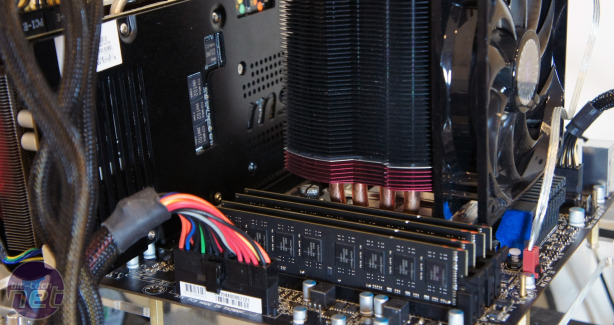Test Seup
- Intel Core i7-2600K - 4(8) - Hyperthreading Enabled, TurboBoost and C1E Disabled.
- Gigabyte GA-P67A-UD4 - (Intel P67 F5r BIOS)
- 4GB G.Skill Perfect Storm 2,200MHz CL8
Intel 'Sandy Bridge'
- Intel Core i7-860 - 4(8) - Hyperthreading Enabled, TurboBoost and C1E Disabled.
- Asus P7P55 Deluxe - (Intel P55 1901 BIOS)
- 4GB G.Skill Perfect Storm 2,200MHz CL8
Intel 'Lynnfield
- Intel Core i7-940 - 4(8) - Hyperthreading Enabled, TurboBoost and C1E Disabled.
- Gigabyte GA-X58A-UD7 - (Intel X58/ICH10R FB BIOS)
- 6GB Corsair Dominator 1,600MHz CL8
Intel 'Nehalem'
- MSI GeForce GTX 480 Lightning Graphics Card
- GeForce Driver Version 260.66
- Crucial RealSSD C300 128GB
- 650W Seasonic X-series PSU
- Microsoft 7 Home Premium x64
Common Components
Memory Speeds Tested
- (3,000MHz CPU) 100MHz x 30: 1,333MHz - 9-9-9-24-1T
- (3,000MHz CPU) 100MHz x 30: 1,600MHz - 9-9-9-24-1T
- (3,000MHz CPU) 100MHz x 30: 1,866MHz - 9-9-9-24-1T
- (3,000MHz CPU) 100MHz x 30: 2,133MHz - 9-9-9-24-1T
Intel Sandy Bridge
- (2,992MHz CPU / 2,448MHz CPU Uncore) 136MHz x 22: 1,360MHz - 9-9-9-24-1T
- (2,992MHz CPU / 2,448MHz CPU Uncore) 136MHz x 22: 1,632MHz - 9-9-9-24-1T
- (3,002MHz CPU / 2,844MHz CPU Uncore) 158MHz x 19: 1,896MHz - 9-9-9-24-1T
- (3,009MHz CPU / 3,186MHz CPU Uncore) 177MHz x 17: 2,124MHz - 9-9-9-24-1T
Intel Lynnfield
- (2,992MHz CPU / 2,720MHz CPU Uncore) 136MHz x 22: 1,360MHz - 9-9-9-24-1T
- (2,992MHz CPU / 3,264MHz CPU Uncore) 136MHz x 22: 1,632MHz - 9-9-9-24-1T
Intel Nehalem
We found that our Core i7-940 couldn't use a memory frequency above 1,600MHz, because at 1,866MHz it required a 3.7GHz CPU Uncore, which was beyond its scope. The more recent 32nm Intel Core i7-980X Extreme Edition only requires a 1.5x CPU:Uncore ratio, which enables higher memory speeds. However, even with two cores disabled, its 12MB of L3 cache would have given it a performance advantage over the other CPUs and their 8MB of L3 cache.

MSI MPG Velox 100R Chassis Review
October 14 2021 | 15:04










Want to comment? Please log in.